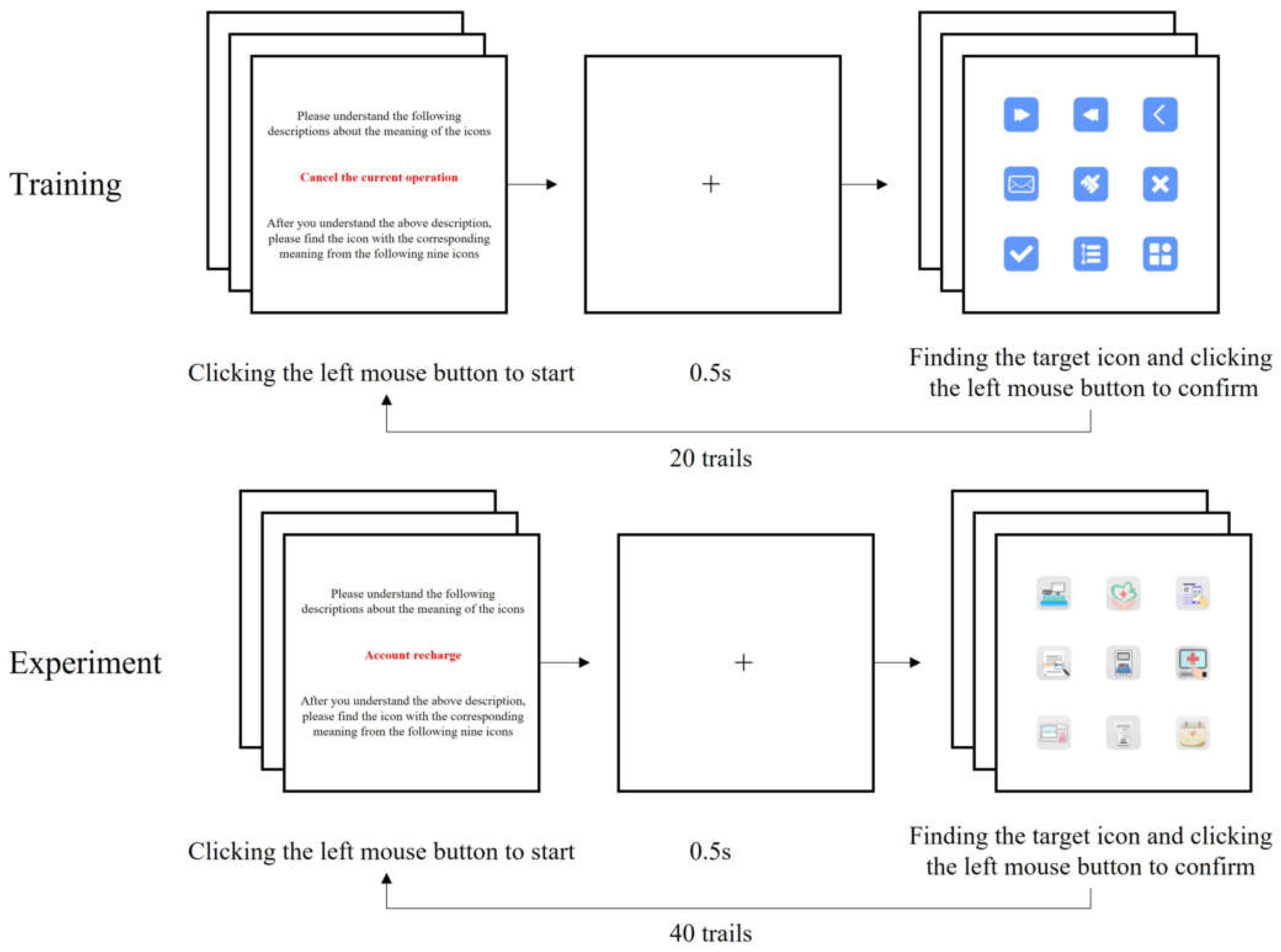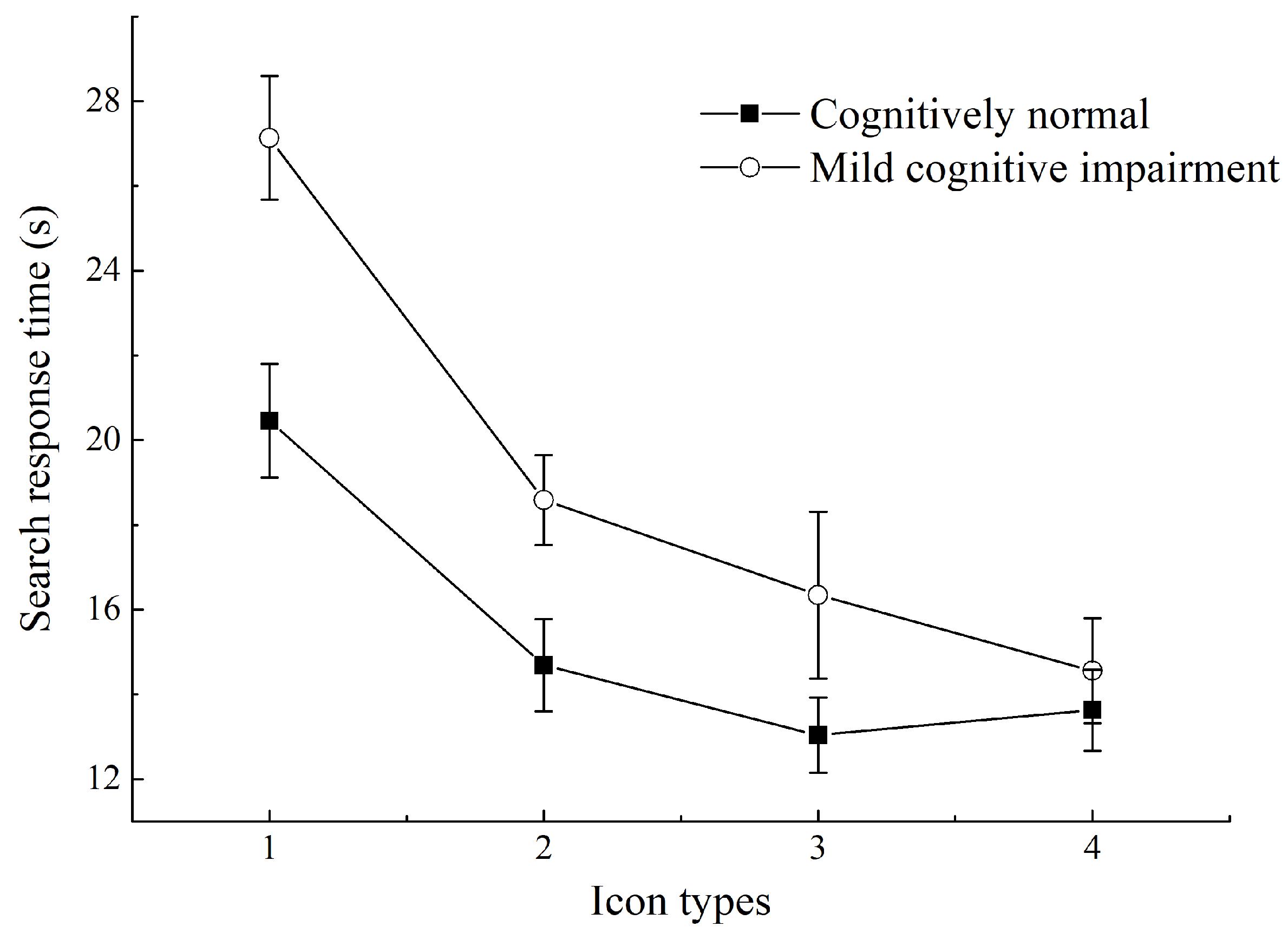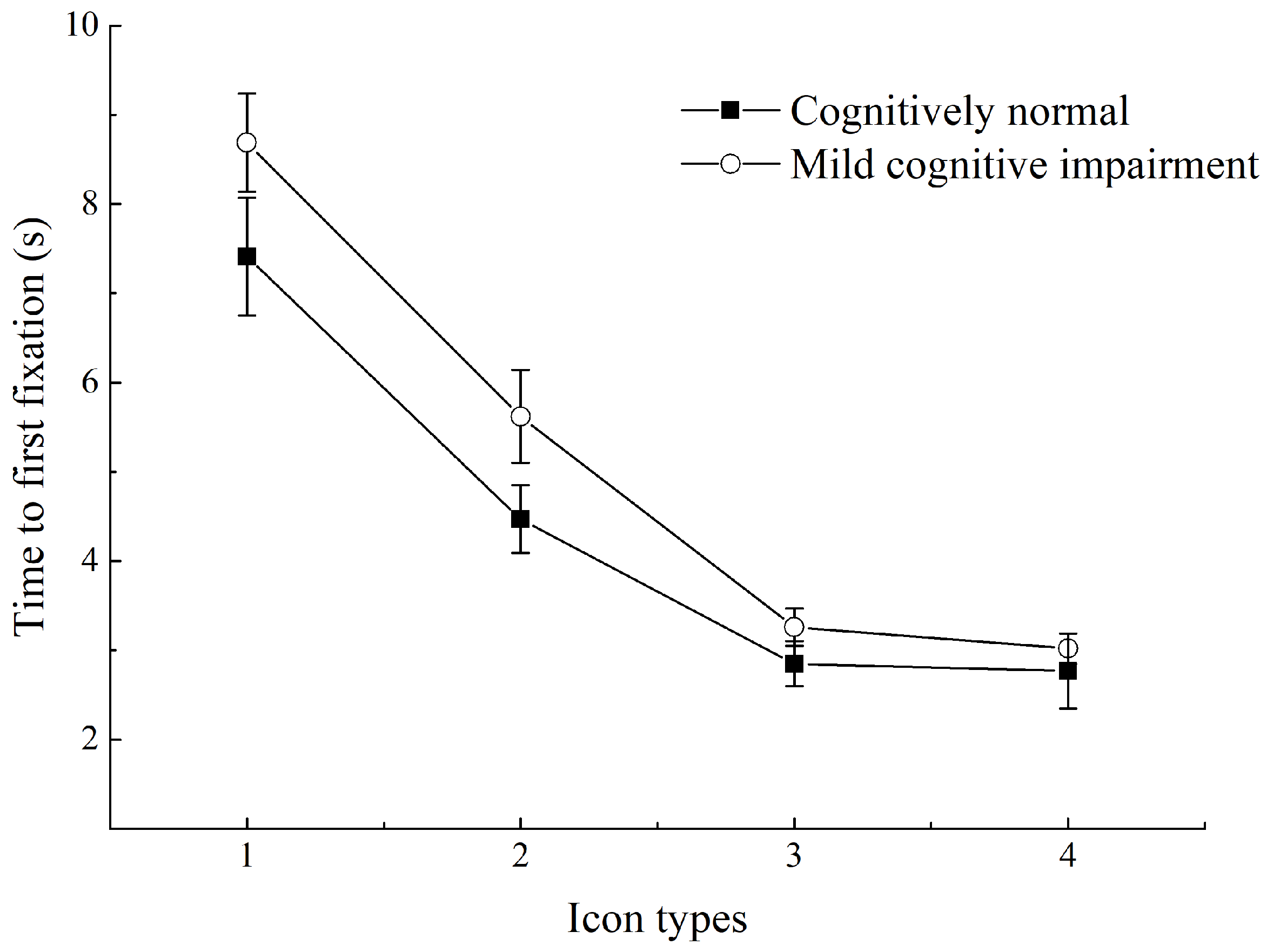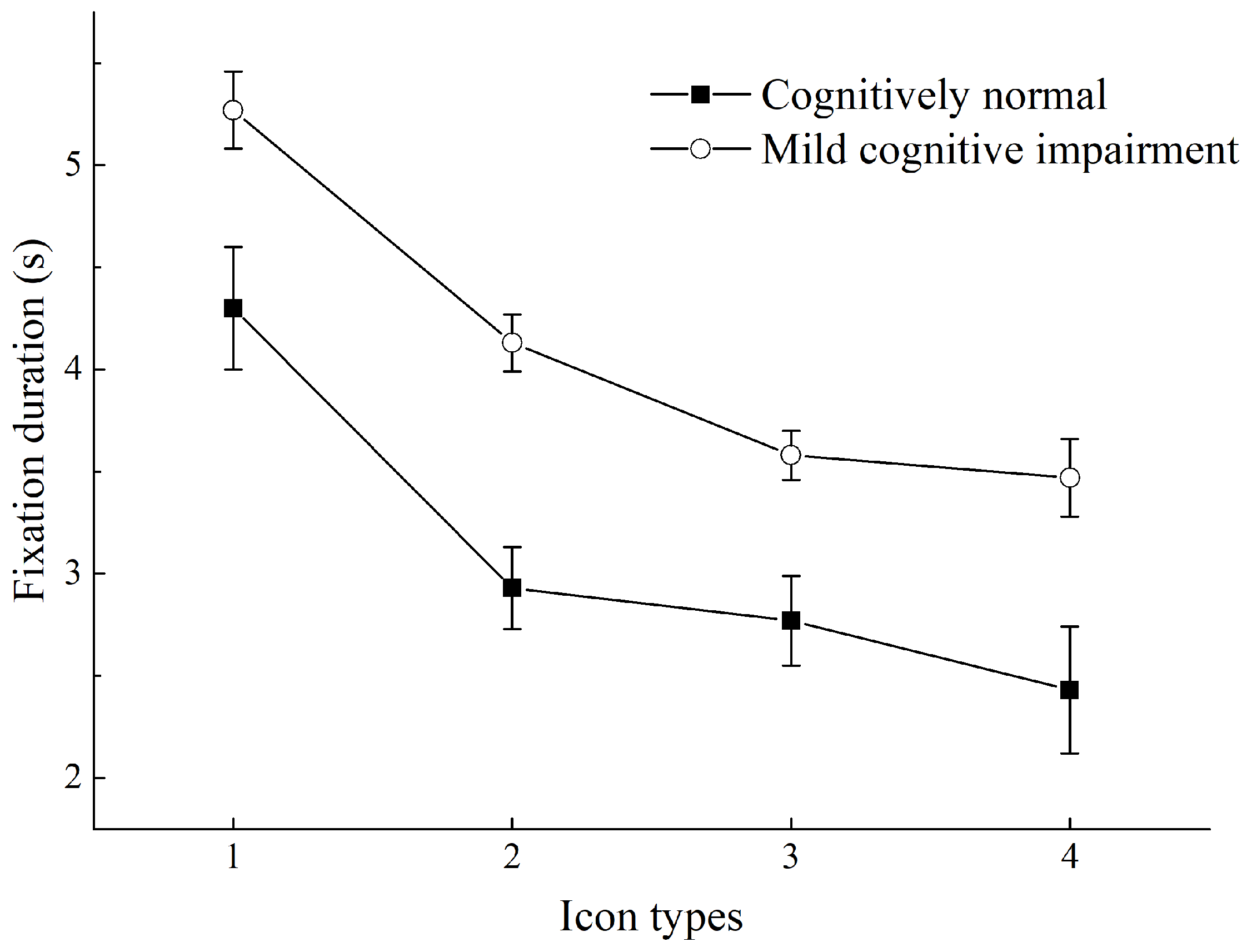How Do Older Adults Process Icons in Visual Search Tasks? The Combined Effects of Icon Type and Cognitive Aging
Abstract
:1. Introduction
2. Materials and Methods
2.1. Experimental Design
2.2. Selection and Design of the Experimental Materials
2.3. Experimental Equipment and Participants
2.3.1. Experimental System
2.3.2. Participants
2.4. Experimental Design and Procedures
2.5. Statistical Analysis
3. Results
3.1. Visual Search Accuracy
3.2. Search Response Time
3.3. Time to First Fixation (TFF)
3.4. Fixation Duration (FD)
4. Discussion
4.1. Main Findings
4.1.1. Effect of Icon Types on Visual Search Performance of Older Adults
4.1.2. Effects of Cognitive Aging on Icon Search Performance in Older Adults
4.1.3. Interactive Effect of Icon Types and Cognitive Aging on Visual Search Performance of Older Adults
4.2. Limitations and Future Research
5. Conclusions
Author Contributions
Funding
Institutional Review Board Statement
Informed Consent Statement
Data Availability Statement
Conflicts of Interest
References
- Britt, A.E.; Ferrara, C.; Mirman, D. Distinct Effects of Lexical and Semantic Competition during Picture Naming in Younger Adults, Older Adults, and People with Aphasia. Front. Psychol. 2016, 7, 813. [Google Scholar] [CrossRef] [PubMed] [Green Version]
- Gordon, P.C.; Islam, A.T.; Wright, H.H. Rapid automatized naming (RAN): Effects of aging on a predictor of reading skill. Aging Neuropsychol. Cogn. 2021, 28, 632–644. [Google Scholar] [CrossRef] [PubMed]
- Boutet, I.; Milgram, N.W.; Freedman, M. Cognitive decline and human (Homo sapiens) aging: An investigation using a comparative neuropsychological approach. J. Comp. Psychol. 2007, 121, 270–281. [Google Scholar] [CrossRef] [PubMed]
- Harada, C.N.; Love, M.C.N.; Triebel, K.L. Normal Cognitive Aging. Clin. Geriatr. Med. 2013, 29, 737–752. [Google Scholar] [CrossRef] [Green Version]
- Petersen, R.C. Mild cognitive impairment: Transition between aging and Alzheimer’s disease. Neurologia 2000, 15, 93–101. [Google Scholar] [CrossRef]
- Goncalves de Freitas Pereira, M.L.; de Arruda Camargo, M.V.Z.; Ribeiro Bellan, A.F.; Tahira, A.C.; dos Santos, B.; dos Santos, J.; Machado-Lima, A.; Nunes, F.L.S.; Forlenza, O.V. Visual Search Efficiency in Mild Cognitive Impairment and Alzheimer’s Disease: An Eye Movement Study. J. Alzheimers Dis. 2020, 75, 261–275. [Google Scholar] [CrossRef]
- Vega, J.N.; Newhouse, P.A. Mild Cognitive Impairment: Diagnosis, Longitudinal Course, and Emerging Treatments. Curr. Psychiatry Rep. 2014, 16, 490. [Google Scholar] [CrossRef] [Green Version]
- Riley, P.; Alm, N.; Newell, A. An interactive tool to promote musical creativity in people with dementia. Comput. Hum. Behav. 2009, 25, 599–608. [Google Scholar] [CrossRef]
- Scialfa, C.; Spadafora, P.; Klein, M.; Lesnik, A.; Dial, L.; Heinrich, A. Iconic Sign Comprehension in Older Adults: The Role of Cognitive Impairment and Text Enhancement. Can. J. Aging Rev. Can. Du Vieil. 2008, 27, 253–265. [Google Scholar] [CrossRef]
- Leung, R.; McGrenere, J.; Graf, P. Age-related differences in the initial usability of mobile device icons. Behav. Inf. Technol. 2011, 30, 629–642. [Google Scholar] [CrossRef]
- Granata, C.; Pino, M.; Legouverneur, G.; Vidal, J.S.; Bidaud, P.; Rigaud, A.S. Robot services for elderly with cognitive impairment: Testing usability of graphical user interfaces. Technol. Health Care 2013, 21, 217–231. [Google Scholar] [CrossRef] [PubMed]
- Huang, S.-C.; Bias, R.G.; Schnyer, D. How Are Icons Processed by the Brain? Neuroimaging Measures of Four Types of Visual Stimuli Used in Information Systems. J. Assoc. Inf. Sci. Technol. 2015, 66, 702–720. [Google Scholar] [CrossRef]
- Ma, X.; Matta, N.; Cahier, J.-P.; Qin, C.; Cheng, Y. From action icon to knowledge icon: Objective-oriented icon taxonomy in computer science. Displays 2015, 39, 68–79. [Google Scholar] [CrossRef]
- Silvennoinen, J.M.; Kujala, T.; Jokinen, J.P.P. Semantic distance as a critical factor in icon design for in-car infotainment systems. Appl. Ergon. 2017, 65, 369–381. [Google Scholar] [CrossRef] [Green Version]
- Chen, R.; Huang, J.; Zhou, J. Skeuomorphic or flat icons for an efficient visual search by younger and older adults? Appl. Ergon. 2020, 85, 103073. [Google Scholar] [CrossRef]
- Lei, W.; Tian, L.; Juan, L.; Bin, L. Skeuomorphism and Flat Design: Evaluating Users’ Emotion Experience in Car Navigation Interface Design; Springer: Cham, Switzerland, 2015; pp. 567–575. [Google Scholar]
- Kreps, D.; Burmeister, O.K.; Blaynee, J. Skeuomorphic Reassurance: Personhood and Dementia. In Proceedings of the 12th IFIP TC 9 International Conference on Human Choice and Computers (HCC), Salford, UK, 7–9 September 2016; pp. 61–71. [Google Scholar]
- Backhaus, N.; Trapp, A.K.; Thuering, M. Skeuomorph versus Flat Design: User Experience and Age-Related Preferences. In Proceedings of the 7th International Conference on Design, User Experience, and Usability (DUXU) Held as Part of 20th International Conference on Human-Computer Interaction (HCI International), Las Vegas, NV, USA, 15 July 2018; pp. 527–542. [Google Scholar]
- Shahid, S.; ter Voort, J.; Somers, M.; Mansour, I.; Assoc Comp, M. Skeuomorphic, Flat or Material Design: Requirements for Designing Mobile Planning Applications for Students with Autism Spectrum Disorder. In Proceedings of the 18th International Conference on Human-Computer Interaction with Mobile Devices and Services (MobileHCI), Florence, Italy, 6–9 September 2016; pp. 738–745. [Google Scholar]
- Urbano, I.C.V.P.; Guerreiro, J.P.V.; Nicolau, H.M.A.A. From skeuomorphism to flat design: Age-related differences in performance and aesthetic perceptions. Behav. Inf. Technol. 2020, 2020, 1–16. [Google Scholar] [CrossRef]
- Dosso, C.; Chevalier, A. How do older adults process icons during a navigation task? Effects of aging, semantic distance, and text label. Educ. Gerontol. 2021, 47, 134–149. [Google Scholar] [CrossRef]
- Hou, G.; Hu, Y. Designing Combinations of Pictogram and Text Size for Icons: Effects of Text Size, Pictogram Size, and Familiarity on Older Adults’ Visual Search Performance. Hum. Factors 2021, 2021, 00187208211061938. [Google Scholar] [CrossRef]
- Ng, A.W.Y.; Siu, K.W.M.; Chan, C.C.H. The effects of user factors and symbol referents on public symbol design using the stereotype production method. Appl. Ergon. 2012, 43, 230–238. [Google Scholar] [CrossRef]
- Schroeder, S.; Ziefle, M. Effects of icon concreteness and complexity on semantic transparency: Younger vs. older users. In Proceedings of the 11th International Conference on Computers Helping People with Special Needs, Linz, Austria, 9–11 July 2008; pp. 90–97. [Google Scholar]
- Xi, T.; Wu, X. The Influence of Different Style of Icons on Users’ Visual Search in Touch Screen Interface. In Proceedings of the AHFE International Conference on Ergonomics in Design, Los Angeles, CA, USA, 17–21 July 2017; pp. 222–232. [Google Scholar]
- Wiedenbeck, S. The use of icons and labels in an end user application program: An empirical study of learning and retention. Behav. Inf. Technol. 1999, 18, 68–82. [Google Scholar] [CrossRef]
- Reddy, G.R.; Blackler, A.; Popovic, V.; Thompson, M.H.; Mahar, D. The effects of redundancy in user-interface design on older users. Int. J. Hum. Comput. Stud. 2020, 137, 102385. [Google Scholar] [CrossRef]
- Lawry, S.; Popovic, V.; Blackler, A.; Thompson, H. Age, familiarity, and intuitive use: An empirical investigation. Appl. Ergon. 2019, 74, 74–84. [Google Scholar] [CrossRef] [PubMed]
- Narasimha, S.; Agnisarman, S.; Madathil, K.C.; Gramopadhye, A.; McElligott, J.T. Designing Home-Based Telemedicine Systems for the Geriatric Population: An Empirical Study. Telemed. E-Health 2018, 24, 94–110. [Google Scholar] [CrossRef]
- Wildenbos, G.A.; Jaspers, M.W.M.; Schijven, M.P.; Dusseljee-Peute, L.W. Mobile health for older adult patients: Using an aging barriers framework to classify usability problems. Int. J. Med. Inform. 2019, 124, 68–77. [Google Scholar] [CrossRef] [PubMed]
- Shen, Z.; Xue, C.; Wang, H. Effects of Users’ Familiarity with the Objects Depicted in Icons on the Cognitive Performance of Icon Identification. I-Percept. 2018, 9, 2041669518780807. [Google Scholar] [CrossRef] [PubMed] [Green Version]
- Shen, Z.; Zhang, L.; Xiao, X.; Li, R.; Liang, R. Icon Familiarity Affects the Performance of Complex Cognitive Tasks. I-Percept. 2020, 11, 2041669520910167. [Google Scholar] [CrossRef] [PubMed]
- Ng, A.W.Y.; Chan, A.H.S. The guessability of traffic signs: Effects of prospective-user factors and sign design features. Accid. Anal. Prev. 2007, 39, 1245–1257. [Google Scholar] [CrossRef]
- McDougall, S.; Reppa, I.; Kulik, J.; Taylor, A. What makes icons appealing? The role of processing fluency in predicting icon appeal in different task contexts. Appl. Ergon. 2016, 55, 156–172. [Google Scholar] [CrossRef]
- Liu, Y.-C.; Ho, C.-H. The effects of age on symbol comprehension in central rail hubs in Taiwan. Appl. Ergon. 2012, 43, 1016–1025. [Google Scholar] [CrossRef]
- Thomann, A.E.; Berres, M.; Goettel, N.; Steiner, L.A.; Monsch, A.U. Enhanced diagnostic accuracy for neurocognitive disorders: A revised cut-off approach for the Montreal Cognitive Assessment. Alzheimers Res. Ther. 2020, 12, 39. [Google Scholar] [CrossRef]
- Lees, R.; Selvarajah, J.; Fenton, C.; Pendlebury, S.T.; Langhorne, P.; Stott, D.J.; Quinn, T.J. Test Accuracy of Cognitive Screening Tests for Diagnosis of Dementia and Multidomain Cognitive Impairment in Stroke. Stroke 2014, 45, 3008–3018. [Google Scholar] [CrossRef] [PubMed] [Green Version]
- Page, T. Skeuomorphism or flat design: Future directions in mobile device User Interface (UI) design education. Int. J. Mob. Learn. Organ. 2014, 8, 130–142. [Google Scholar] [CrossRef] [Green Version]
- Shinar, D.; Vogelzang, M. Comprehension of traffic signs with symbolic versus text displays. Transp. Res. Part F-Traffic Psychol. Behav. 2013, 18, 72–82. [Google Scholar] [CrossRef]
- Huang, H.; Yang, M.; Yang, C.; Lv, T. User performance effects with graphical icons and training for elderly novice users: A case study on automatic teller machines. Appl. Ergon. 2019, 78, 62–69. [Google Scholar] [CrossRef]
- Burmistrov, I.; Zlokazova, T.; Izmalkova, A.; Leonova, A. Flat Design vs Traditional Design: Comparative Experimental Study. In Proceedings of the 15th IFIP TC.13 International Conference on Human-Computer Interaction (INTERACT), Bamberg, Germany, 14–18 September 2015; pp. 106–114. [Google Scholar]
- Campbell, K.L.; Lustig, C.; Hasher, L. Aging and Inhibition: Introduction to the Special Issue. Psychol. Aging 2020, 35, 605–613. [Google Scholar] [CrossRef]
- Sperduti, M.; Makowski, D.; Piolino, P. The protective role of long-term meditation on the decline of the executive component of attention in aging: A preliminary cross-sectional study. Aging Neuropsychol. Cogn. 2016, 23, 691–702. [Google Scholar] [CrossRef]
- Haesner, M.; Chandra, J.; Steinert, A.; Steinhagen-Thiessen, E. An eye movement analysis of web usability: Differences between older adults with and without mild cognitive impairment. Assist. Technol. 2018, 30, 66–73. [Google Scholar] [CrossRef]






| Flat Icons (n = 27) | Skeuomorphic Icons (n = 27) | F | p | |||
|---|---|---|---|---|---|---|
| M | SD | M | SD | |||
| Complexity | 2.77 | 0.08 | 2.81 | 0.09 | 2.78 | 0.101 |
| Familiarity | 3.28 | 0.06 | 3.31 | 0.06 | 3.53 | 0.066 |
| Semantic distance | 5.76 | 0.09 | 5.80 | 0.11 | 2.28 | 0.137 |
| NC | MCI | |
|---|---|---|
| N | 8 | 8 |
| Sex | M = 4; F = 4 | M = 4; F = 4 |
| Age (SD 1) | 62.13 (2.10) | 61.25 (1.39) |
| Education level (SD) | 8 (1.41) | 8.88 (2.70) |
| Accuracy | Response Time (s) | Time to First Fixation (s) | Fixation Duration (s) | |
|---|---|---|---|---|
| Flat icons (FIs) | 0.40 (0.04) | 23.80 (1.07) | 8.05 (0.16) | 4.78 (0.06) |
| Skeuomorphic icons (SIs) | 0.74 (0.04) | 16.64 (0.28) | 5.04 (0.12) | 3.53 (0.04) |
| FI + text | 0.95 (0.04) | 14.69 (0.41) | 3.05 (0.06) | 3.18 (0.04) |
| SI + text | 0.96 (0.02) | 14.09 (0.29) | 2.90 (0.08) | 2.95 (0.06) |
| CN | 0.81 (0.03) | 15.45 (0.57) | 4.37 (0.81) | 3.11 (0.05) |
| MCI | 0.71 (0.03) | 19.15 (0.53) | 5.15 (0.76) | 4.11 (0.05) |
| FI × CN | 0.51 (0.16) | 20.46 (1.34) | 7.41 (0.66) | 4.3 (0.30) |
| FI × MCI | 0.28 (0.15) | 27.14 (5.47) | 8.69 (0.55) | 5.27 (0.19) |
| SI × CN | 0.77 (0.14) | 14.69 (1.08) | 4.47 (0.38) | 2.93 (0.20) |
| SI × MCI | 0.70 (0.15) | 18.59 (1.06) | 5.62 (0.52) | 4.13 (0.14) |
| FI + text × CN | 1.00 (0) | 13.04 (0.89) | 2.85 (0.25) | 2.77 (0.22) |
| FI + text × MCI | 0.90 (0.19) | 16.34 (1.97) | 3.26 (0.21) | 3.58 (0.12) |
| SI + text × CN | 0.97 (0.08) | 13.63 (0.96) | 2.77 (0.42) | 2.43 (0.31) |
| SI + text × MCI | 0.95 (0.09) | 14.56 (1.24) | 3.02 (0.17) | 3.47 (0.19) |
| Response Time | Accuracy | Time to First Fixation | Fixation Duration | |||||||||
|---|---|---|---|---|---|---|---|---|---|---|---|---|
| F | p | ηp2 | F | p | ηp2 | F | p | ηp2 | F | p | ηp2 | |
| Icon type | 69.56 | 0.000 | 0.84 | 67.08 | 0.000 | 0.84 | 482.00 | 0.000 | 0.97 | 288.59 | 0.000 | 0.98 |
| Cognitive level | 22.78 | 0.000 | 0.64 | 7.48 | 0.017 | 0.37 | 48.28 | 0.000 | 0.79 | 195.90 | 0.000 | 0.94 |
| Icon type × Cognitive level | 4.88 | 0.006 | 0.27 | 2.08 | 0.118 | 0.14 | 5.63 | 0.003 | 0.30 | 2.79 | 0.053 | 0.18 |
Publisher’s Note: MDPI stays neutral with regard to jurisdictional claims in published maps and institutional affiliations. |
© 2022 by the authors. Licensee MDPI, Basel, Switzerland. This article is an open access article distributed under the terms and conditions of the Creative Commons Attribution (CC BY) license (https://creativecommons.org/licenses/by/4.0/).
Share and Cite
Wu, J.; Jiao, D.; Lu, C.; Li, C.; Huang, X.; Weng, S. How Do Older Adults Process Icons in Visual Search Tasks? The Combined Effects of Icon Type and Cognitive Aging. Int. J. Environ. Res. Public Health 2022, 19, 4525. https://doi.org/10.3390/ijerph19084525
Wu J, Jiao D, Lu C, Li C, Huang X, Weng S. How Do Older Adults Process Icons in Visual Search Tasks? The Combined Effects of Icon Type and Cognitive Aging. International Journal of Environmental Research and Public Health. 2022; 19(8):4525. https://doi.org/10.3390/ijerph19084525
Chicago/Turabian StyleWu, Jianfeng, Dongfang Jiao, Chunfu Lu, Chengmin Li, Xiaofang Huang, and Suzan Weng. 2022. "How Do Older Adults Process Icons in Visual Search Tasks? The Combined Effects of Icon Type and Cognitive Aging" International Journal of Environmental Research and Public Health 19, no. 8: 4525. https://doi.org/10.3390/ijerph19084525
APA StyleWu, J., Jiao, D., Lu, C., Li, C., Huang, X., & Weng, S. (2022). How Do Older Adults Process Icons in Visual Search Tasks? The Combined Effects of Icon Type and Cognitive Aging. International Journal of Environmental Research and Public Health, 19(8), 4525. https://doi.org/10.3390/ijerph19084525






